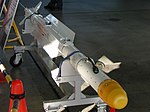The Mitsubishi AAM-5 (Type 04 air-to-air missile, 04式空対空誘導弾) is a short-range air-to-air missile developed and produced by Mitsubishi Heavy Industries for the Japan Air Self-Defense Force.[1] Development of the missile as a replacement for the AAM-3 (Type 90) missile commenced in 1991, and it has been operational since 2004.
Characteristics
Unlike the Type 90 guided missile, the AAM-5 does not have canard control surfaces, using thrust vectoring for high agility. The missile body has narrow strakes extending over most of its length.
The NEC manufactured seeker has also been improved. Addition of a triaxial gimbal to the infrared seeker has increased the field of view, and an infrared focal plane array multi-element seeker allows infrared imaging. In particular, the addition of an INS means mid-course updates and LOAL (Lock-on after launch) is possible. Terminal homing is via infrared imaging (IIR). In terms of generation, it is placed in the same generation as missiles such as the AIM-9X and IRIS-T.
Variants
- AAM-5
- Standard.
- AAM-5B
- Enhanced background discrimination capability and IRCCM. Seeker cooling time is extended by the adoption of a Stirling engine.
Operators
 Japan
Japan
Gallery
-
Dummy
-
Seeker
Specifications
- Length: 3,105 mm
- Diameter: 130 mm
- Wing span: 440 mm
- Weight: 95 kg
- Guidance: AAM-5A: Terminal Infrared homing (IIR), INS+COLOS
- Guidance: AAM-5B: Terminal IIR with IRCCM, INS+COLOS)
- Warhead: blast fragmentation warhead
- Detonation Mechanism: laser proximity fuze and impact
- Range: 35 km
- Speed: Mach 3+
See also
- IRIS-T – (Germany, Italy, Sweden, Greece) - Similar missile
- AAM-1 – (Japan)
- AAM-2 – (Japan)
- AAM-3 – (Japan)
- AAM-4 – (Japan)
References
- ^ "Mitsubishi AAM-5". weaponsystems.net. Retrieved 14 August 2023.






Recent Comments